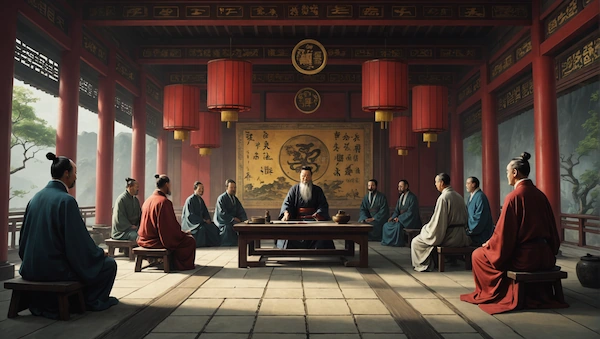
Introduction: A Modern Philosophy of Joy
Tenrikyo stands as a remarkable Japanese spiritual movement that emerged in the 19th century, embodying principles that transcend conventional religious observance. Rather than focusing solely on ritualistic practices, Tenrikyo aspires to cultivate a comprehensive philosophy of life—one that promotes profound joy, holistic health, and harmonious relationships among individuals and communities. Originating from a transcendent revelation received by Miki Nakayama, a woman of humble origins, Tenrikyo has evolved into a global faith tradition that emphasizes the intimate relationship between the divine and humanity, the fundamental interconnectedness of all sentient beings, and the paramount significance of joyous living as a spiritual practice. This comprehensive exploration delves into Tenrikyo’s origins, examines its core philosophical tenets, situates it within the broader tapestry of Eastern and Western spiritual traditions, and assesses its contemporary relevance in addressing the complex challenges of modern existence.
Historical Origins of Tenrikyo
The Life and Revelation of Miki Nakayama
Tenrikyo traces its genesis to a transformative moment in 1838 when Miki Nakayama, later reverentially addressed as “Oyassama” (Our Parent), experienced a profound spiritual revelation while engaged in deep prayer at her modest home in the rural village of Takamizawa, Japan. This pivotal moment marked the beginning of her extraordinary role as a conduit through which divine wisdom and truth would be articulated to humanity. Her reputation spread quickly throughout the region as accounts of spontaneous healings of physical ailments through her spiritual intervention began to circulate, solidifying her status as a genuine spiritual authority within the community. Through her teachings, Miki urged her followers to fundamentally reconsider their relationship with the divine and to embrace a new understanding of spiritual truth that transcended conventional religious boundaries of the time.
Miki Nakayama’s background is particularly significant in understanding the development of Tenrikyo. Born in 1798 to a family of farmers, she lived an ordinary life as a wife and mother until her revelation at age forty. Prior to this transformative experience, she had demonstrated exceptional devotion to her family, even during periods of economic hardship. This foundation of selfless service would later become a cornerstone of Tenrikyo teachings. Her transformation from an ordinary Japanese woman to a spiritual leader was remarkable in the context of 19th century Japan’s patriarchal society, where women rarely assumed positions of religious authority.
Development and Institutional Evolution
The early followers of Miki Nakayama formed an intimate spiritual community around her charismatic leadership, sharing testimonies of divine influence and miraculous healing experiences. What began as a small gathering of devoted adherents gradually expanded into a more formalized movement, gaining official recognition when the name “Tenrikyo” was formally established in 1882. This period also saw the creation of the “Kinshi”—a comprehensive set of normative teachings codified in the “Ofudesaki” (Tip of the Writing Brush), a revelatory text containing explicit spiritual guidance for adherents. This sacred scripture, comparable to foundational texts in other major religious traditions, serves as the theological and philosophical cornerstone upon which the diverse doctrines and practices of Tenrikyo are constructed.
The institutionalization of Tenrikyo progressed significantly in 1896 when the Japanese government officially acknowledged it as a distinct religious organization. This formal recognition occurred during the Meiji era, a period marked by Japan’s rapid modernization and complex religious reforms that often restricted new spiritual movements. By successfully navigating these challenging political circumstances, Tenrikyo solidified its legitimate position within the broader spectrum of Japanese religious life while maintaining its distinctive spiritual path that elegantly bridges everyday practical concerns with profound metaphysical insights.
The establishment of Tenrikyo Church Headquarters in Tenri City, Nara Prefecture, further cemented the movement’s organizational structure. This central administrative hub became not only the spiritual center for adherents but also facilitated the systematic dissemination of Tenrikyo teachings throughout Japan and, eventually, internationally. The headquarters complex includes the Main Sanctuary (Jiba), considered the primordial home of human creation and the spiritual nexus where divine energy is most concentrated—a concept that adds a sacred geographical dimension to Tenrikyo’s cosmology.
Core Philosophical and Spiritual Principles of Tenrikyo
Joy and the Nature of Human Existence
At the philosophical heart of Tenrikyo lies the profound conceptualization of joy (yōki) as the fundamental and intended condition of human existence. This joy transcends mere emotional satisfaction, touching upon the deepest spiritual essence of humanity as articulated in the revelatory teachings of Miki Nakayama. The “Ofudesaki” contains the pivotal declaration: “Joyous life is the goal of heaven and earth,” a succinct yet profound statement that encapsulates Tenrikyo’s core belief that true fulfillment and divine purpose manifest through a joyful disposition. This philosophical position suggests that joy functions simultaneously as both the ultimate spiritual goal and as a divine gift bestowed upon humanity.
For Tenrikyo adherents, joy is intrinsically linked to one’s fundamental orientation toward life, compelling the faithful to consciously cultivate attitudes of profound gratitude and positive engagement with existence. Miki Nakayama consistently emphasized that joy should be actively pursued and deliberately manifested in daily interactions rather than viewed as a distant spiritual achievement. The philosophical underpinning of this teaching suggests that individual expressions of joy contribute meaningfully to collective harmony, fostering a social and spiritual environment in which suffering can be alleviated through compassionate action, empathetic understanding, and robust communal support systems.
Tenrikyo’s conception of joy differs significantly from hedonistic pleasure-seeking or materialistic satisfaction. Instead, it represents a deeper state of spiritual alignment with divine intention—a condition where one recognizes the inherent value in all experiences, even challenging ones, as opportunities for growth and service. This nuanced understanding of joy incorporates elements of gratitude, acceptance, and purposeful living that transcend circumstantial happiness, offering a more sustainable foundation for spiritual well-being that remains accessible even amid life’s inevitable difficulties.
The Concept of God and Humanity’s Relationship with the Divine
Tenrikyo presents a distinctive theological vision, promoting the concept of a singular divine entity as the compassionate creator of humanity, referred to as “Tenri-O-no-Mikoto” or “God the Parent.” The tradition posits that this divine being is fundamentally benevolent and ardently desires for all creation to experience joyful existence. While this theological perspective shares certain commonalities with other monotheistic traditions such as Christianity and Islam, it diverges significantly in its emphasis on direct, unmediated human interaction with the divine without requiring intervention from ecclesiastical authorities or salvific intermediaries.
In Tenrikyo’s theological framework, the relationship between humanity and God is characterized by continuous dialogue and dynamic engagement rather than distant reverence. The central spiritual practice of “Hinokishin,” or selfless service, represents a tangible manifestation of this interconnectedness, encouraging adherents to express their gratitude toward the divine through concrete acts of kindness and service to others. Miki’s teachings illuminate this principle: “In order to return to the Joy of God, we must serve others without reservation.” This articulates a reciprocal spiritual economy where divine joy flows through human acts of compassionate service.
Thus, Tenrikyo emphasizes an experiential and relational approach to divinity, challenging followers to move beyond abstract theological contemplation or individualistic salvation-seeking to embrace their role in a collective spiritual endeavor aimed at universal well-being. This notion of communal spiritual responsibility resonates with Eastern philosophical ideals of interdependence found in Buddhist traditions, while simultaneously aligning with Western humanistic philosophies that emphasize the ethical imperative of altruism and social responsibility.
The Tenrikyo understanding of divinity also incorporates the concept of “ten aspects of God,” representing divine qualities that manifest in human life. These aspects—including providence, protection, guidance, and nurturing—illustrate how divine presence permeates everyday experience, making the abstract notion of God comprehensible through practical manifestations. This theological approach bridges transcendent divinity with immanent presence, offering adherents a conceptual framework for recognizing divine activity in ordinary circumstances.
The Doctrine of Self-Reflection and Holistic Healing
In Tenrikyo’s philosophical system, rigorous self-reflection serves as the essential foundation for healing both body and spirit. The tradition’s medical philosophy posits that physical ailments often originate from spiritual disharmony or misalignment with divine intention, leading practitioners to engage deeply with their emotions, thoughts, and actions to identify the underlying spiritual issues that may contribute to their suffering. This introspective approach finds clear expression in Miki Nakayama’s guidance: “Whenever something happens, ask yourself, ‘What did I do to bring this about?'” This teaching encourages personal accountability without implying simplistic blame or punishment.
This sophisticated perspective on illness and healing calls upon adherents to assume personal responsibility for their holistic well-being, providing them with spiritual tools to prevent suffering through mindful, conscientious living in alignment with divine principles. Tenrikyo’s approach to healing intersects meaningfully with concepts from traditional East Asian medicine, particularly the notion of Qi (vital life force) and the philosophical emphasis on maintaining personal harmony and energetic balance as prerequisites for physical health.
Tenrikyo’s healing practices include a unique ritual called the “Sazuke,” or Divine Grant, which qualified adherents may administer to those suffering from illness. This healing rite involves channeling divine energy through specific hand movements and prayers, exemplifying the tradition’s belief in direct divine intervention in human health concerns. However, Tenrikyo does not reject conventional medicine; rather, it advocates for a complementary approach that addresses both physical symptoms and spiritual causes, representing an early example of integrative medicine that honors both scientific advancement and spiritual wisdom.
The concept of “dust” (hokori) in Tenrikyo teaching provides a metaphorical framework for understanding how spiritual impurities accumulate in the mind through negative thoughts and actions, eventually manifesting as physical or psychological distress. Through sincere self-reflection, prayer, and virtuous action, these spiritual impurities can be cleansed, restoring the individual to their natural state of joyful health—a state that reflects divine intention for human flourishing.
Tenrikyo in Context: Comparative Spirituality
Intersections With Other Eastern Traditions
When examining Tenrikyo alongside other Eastern spiritual traditions, numerous significant parallels emerge regarding holistic healing methodologies, communal values, and the fundamental interconnectivity of all life. Both Tenrikyo and Buddhism, for instance, emphasize the transformative potential inherent in deep self-reflection and conscious, intentional action. They share a philosophical commitment to addressing suffering through spiritual practice, though their proposed methodologies and ultimate goals differ in important respects.
While Buddhism articulates a path toward enlightenment and liberation from the cycle of suffering (samsara) through the cessation of desire, Tenrikyo encourages its followers to cultivate and express joy as the primary pathway to divine connection and fulfillment. As Miki Nakayama taught: “To the extent that you make others happy, you will find your own happiness.” This teaching illustrates how, while both traditions value introspection and self-awareness, Tenrikyo distinctively intertwines personal spiritual development with active engagement in promoting communal well-being through joyful service.
Additionally, Tenrikyo shares meaningful conceptual parallels with Shintoism, Japan’s indigenous spiritual tradition. The recognition of kami (divine spirits) and the inherent sacredness of creation in Shinto thought resonates deeply within Tenrikyo’s emphasis on harmonizing with divine will and cultivating sincere appreciation for life’s manifold gifts. Both traditions celebrate purification rituals and emphasize direct communion with divine forces without elaborate doctrinal requirements. This spiritual reciprocity between the divine realm and human existence provides fertile philosophical ground for exploring joy as a shared responsibility that extends beyond individual experience to encompass the collective fabric of society and cosmos.
Tenrikyo also exhibits intriguing connections with Confucian ethical principles, particularly in its emphasis on familial respect, social harmony, and the cultivation of virtue through daily practice. The Tenrikyo concept of “three causalities”—causality of origin, causality of seed, and causality of season—echoes Confucian notions of cosmic order while adding distinctive theological dimensions. This philosophical integration demonstrates how Tenrikyo synthesized existing East Asian wisdom traditions while developing its unique spiritual identity within Japan’s complex religious landscape.
Comparisons with Western Religious and Philosophical Traditions
In the broader context of Western spiritual and philosophical traditions, Tenrikyo invites fascinating comparisons to both Christian theology and emergent New Thought movements of the 19th century. The emphasis on joy and the interconnectedness of all beings finds meaningful reflections in the teachings of Jesus Christ, who advocated for universal love, compassionate action, and authentic service to others. Tenrikyo’s ethical doctrines echo Christ’s fundamental commandment to “love thy neighbor as thyself,” embodying essential moral principles central to both faith traditions despite their distinct cultural and historical origins.
Nevertheless, significant theological divergences exist in their respective understandings of divinity and salvation. While mainstream Christianity often emphasizes faith in Jesus Christ as the exclusive path to salvation, Tenrikyo places the responsibility for happiness—and thus spiritual enlightenment—primarily on the individual’s approach to life rather than adherence to specific dogmatic beliefs or rituals. In this philosophical sense, Tenrikyo promotes a more democratized approach to spirituality where each person is empowered to seek connection with the divine through proactive engagement and joyful living without hierarchical mediation.
Moreover, the New Thought movement, which emerged contemporaneously with Tenrikyo in the late 19th century, shares remarkable philosophical resonances with Tenrikyo in its focus on positive thinking, mental causation, and what would later be articulated as the “law of attraction”—the principle that mental states ultimately shape external reality. The emphatic assertion within Tenrikyo that personal consciousness and inner spiritual disposition directly influence our surrounding circumstances aligns closely with this philosophical school, enriching the broader cross-cultural conversation about intentionality, consciousness, and the causal power of human thought patterns.
Tenrikyo’s theological understanding of a singular divine parent who wishes joy for all creation also invites comparison with the Unitarian and Universalist traditions in Western religious thought, which similarly emphasize divine benevolence and universal salvation. These parallels suggest intriguing possibilities for interfaith dialogue and comparative theological exploration despite the distinct cultural contexts from which these traditions emerged.
Contemporary Significance and Global Reach
Tenrikyo in Modern Society
As Tenrikyo continues to evolve in the contemporary world, its philosophical and ethical relevance becomes increasingly pronounced. Emerging within a global context characterized by social fragmentation, spiritual alienation, and mounting challenges to physical and psychological well-being, Tenrikyo’s foundational teachings highlight unity, joy, and compassionate service as essential components for healing both individuals and societies facing complex modern challenges.
In our 21st-century environment marked by unprecedented technological advancement, digital interconnection, and increasing cross-cultural engagement, Tenrikyo’s call to joyful living and communal harmony resonates with particular power, urging adherents to prioritize compassionate action and selfless service amid the often-dehumanizing forces of modern life. The continuing impact of Tenrikyo manifests in its numerous overseas centers and missions established throughout Asia, the Americas, Europe, and beyond, where its teachings attract an increasingly diverse community of practitioners, fostering both intercultural dialogue and renewed appreciation for Japan’s rich spiritual heritage.
Tenrikyo has established educational institutions, including Tenri University and associated schools, which integrate spiritual values with academic excellence. These institutions serve as important centers for both preserving Tenrikyo traditions and engaging with contemporary intellectual and social developments. The Oyasato Institute for the Study of Religion at Tenri University has contributed significantly to comparative religious scholarship, fostering academic engagement with Tenrikyo teachings in dialogue with global intellectual traditions.
Tenrikyo’s Response to Contemporary Challenges
Tenrikyo’s grassroots approach to social welfare and global challenges manifests in extensive humanitarian service projects and community development initiatives, reflecting its foundational ethical principle that “Helping others is the path to happiness.” This institutional commitment to addressing pressing societal issues such as poverty alleviation, disaster relief, environmental stewardship, and mental health support exemplifies the broader implications of Tenrikyo in advocating for a fundamental paradigm shift from self-centered existence to collective, joyful engagement with the welfare of society and planet.
The tradition’s emphasis on personal agency and spiritual responsibility resonates profoundly with contemporary psychological movements that advocate for the centrality of mental health, emotional intelligence, and psychological resilience. The teaching that each individual bears responsibility for cultivating their own happiness through mindful choices and positive attitudes finds striking parallels in modern positive psychology and mindfulness practices. Tenrikyo encourages practitioners to approach personal difficulties through a lens of constructive introspection, challenging them to uncover deeper truths about themselves through authentic dialogue with both divine wisdom and human community.
In addressing environmental concerns, Tenrikyo’s concept of the world as divine creation fosters an ethic of ecological responsibility among adherents. The tradition’s emphasis on gratitude for the bounty of nature and its teaching that humans should live in harmony with divine creation provides spiritual motivation for environmental stewardship. Various Tenrikyo communities have implemented sustainability initiatives and educational programs that connect spiritual values with ecological awareness, demonstrating how ancient wisdom can inform responses to contemporary environmental challenges.
Tenrikyo has also demonstrated remarkable adaptability in engaging with modern communication technologies to disseminate its teachings while preserving their essential spiritual content. Through websites, social media platforms, online publications, and virtual community gatherings, Tenrikyo has expanded its reach to global audiences while maintaining the integrity of its core philosophical principles. This adaptability illustrates how spiritual traditions can engage constructively with technological change without compromising their foundational values.
Conclusion: The Enduring Wisdom of Tenrikyo
In summary, Tenrikyo emerges as a multidimensional spiritual path that holistically encompasses profound philosophical insights and ethical principles centered around the cultivation of joy, communal harmony, and rigorous self-reflection. Born from the revelatory experiences of Miki Nakayama in 19th century Japan, its teachings advocate for active engagement with divine wisdom as a transformative means for both individual spiritual growth and collective social well-being. Through thoughtful comparative analysis with other spiritual traditions, both Eastern and Western, Tenrikyo invites contemporary practitioners to embody a joyous approach to existence while assuming responsibility for both personal and communal quests toward authentic happiness and spiritual fulfillment.
As this remarkable spiritual tradition continues to evolve and adapt within our rapidly changing global landscape, its fundamental call for joy, selfless service, and mutual support serves as a beacon of hope and harmony in an increasingly fragmented world hungry for meaningful connection and authentic purpose. Through its rich narrative history, profound philosophical insights, and practical ethical teachings, Tenrikyo not only offers penetrating wisdom concerning the human condition but also stands as a living testament to the enduring transformative power of spirituality in shaping individual lives and communities for the better.
The philosophical depth of Tenrikyo, with its emphasis on the inherent dignity of all persons and the potential for spiritual transformation through joyful service, offers valuable resources for addressing contemporary ethical challenges. As humanity continues to navigate complex questions regarding technological ethics, global justice, environmental responsibility, and social cohesion, Tenrikyo’s vision of a world united in joyful harmony presents an inspiring alternative to materialistic or individualistic paradigms that often dominate modern discourse. In this way, what began as a humble revelation to a Japanese woman in the 19th century continues to offer profound spiritual wisdom relevant to humanity’s shared future in the 21st century and beyond.
The Series: Major Eastern Philosophies
1. Taoism: A Journey Through Time, Philosophy, and Spirituality
2. Buddhism: Exploring Its Roots, Teachings, and Worldwide Impact
3. Confucianism: Historical Background, Core Ideas, and Influence Today
4. Shinto: From Ancient Beginnings to Modern-Day Importance
5. Muism: Historical Significance and Modern Perspectives
6. Hinduism: A Rich and Varied Philosophical and Spiritual Tradition
7. Jainism: Historical Evolution and Spiritual Relevance
8. Zoroastrianism: The Transition From Polytheism to Monotheism
9. Tenrikyo: A Modern Japanese Philosophical and Spiritual Movement
10. Sikhism: An Alternative Interpretation of Islam and Hinduism
ARE YOU A TRUE TENRIKYO?
Answer all the questions and choose one response for each of them.
1. What is the fundamental teaching of Tenrikyo regarding human existence?
2. How does Tenrikyo view the concept of God or divine presence?
3. What role does ‘Hinokishin’ play in Tenrikyo practice?
4. What is the significance of ‘Kashimono-Karimono’ (a thing lent, a thing borrowed) in Tenrikyo doctrine?
5. In what way does ‘Yoboku’ contribute to the spread of Tenrikyo teachings?
6. What does ‘Joyous Life’ mean within the context of Tenrikyo beliefs?
The correct answers are the ones corresponding to the letter A. Count the number of times you chose answer A and check your profile below.
0: Tenrikyo is not your thing!
1-2: You are a quite misinformed Tenrikyo
3-4: You are an evolving Tenrikyo
5-6: You are a true expert on Tenrikyo!





